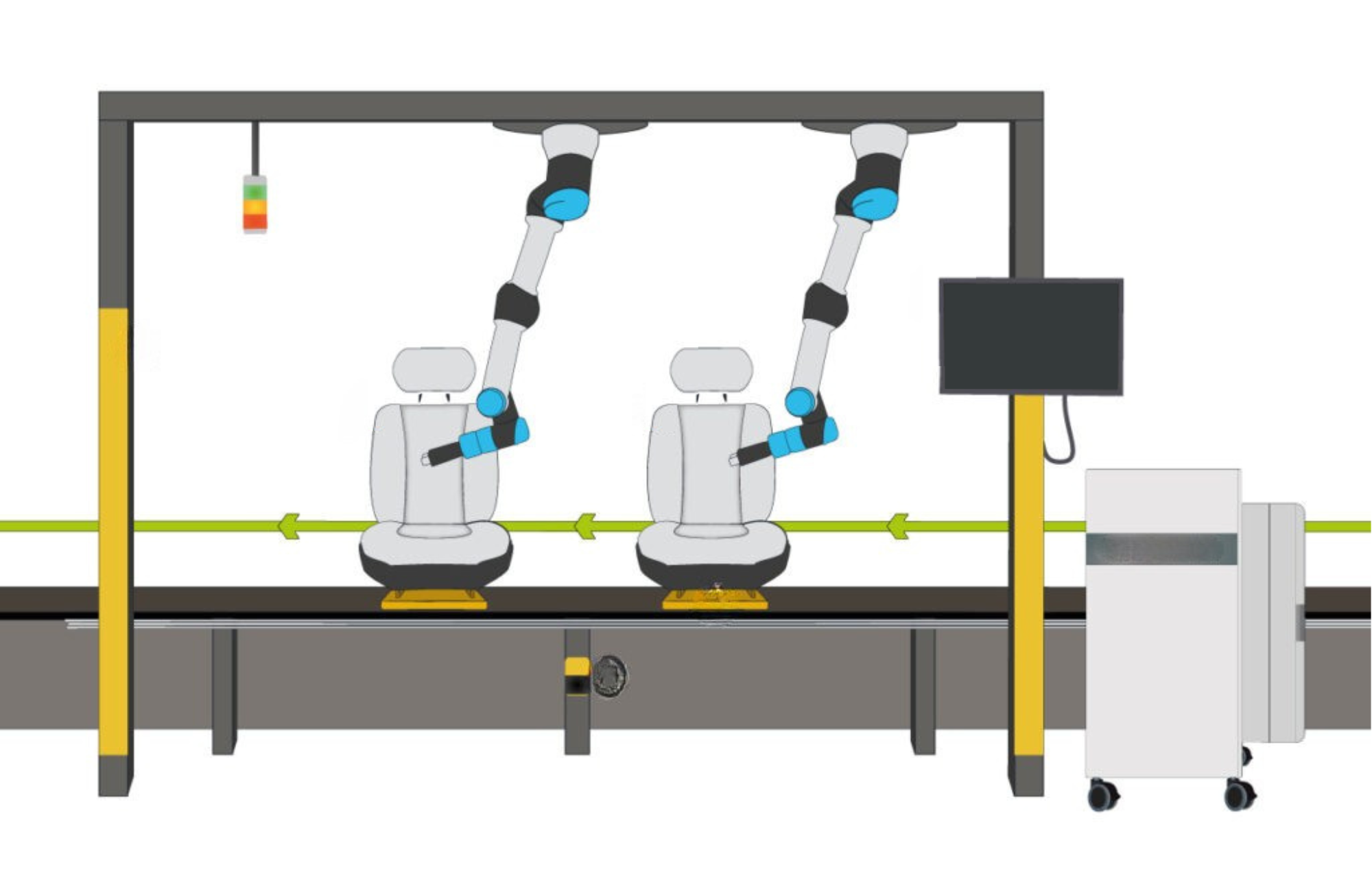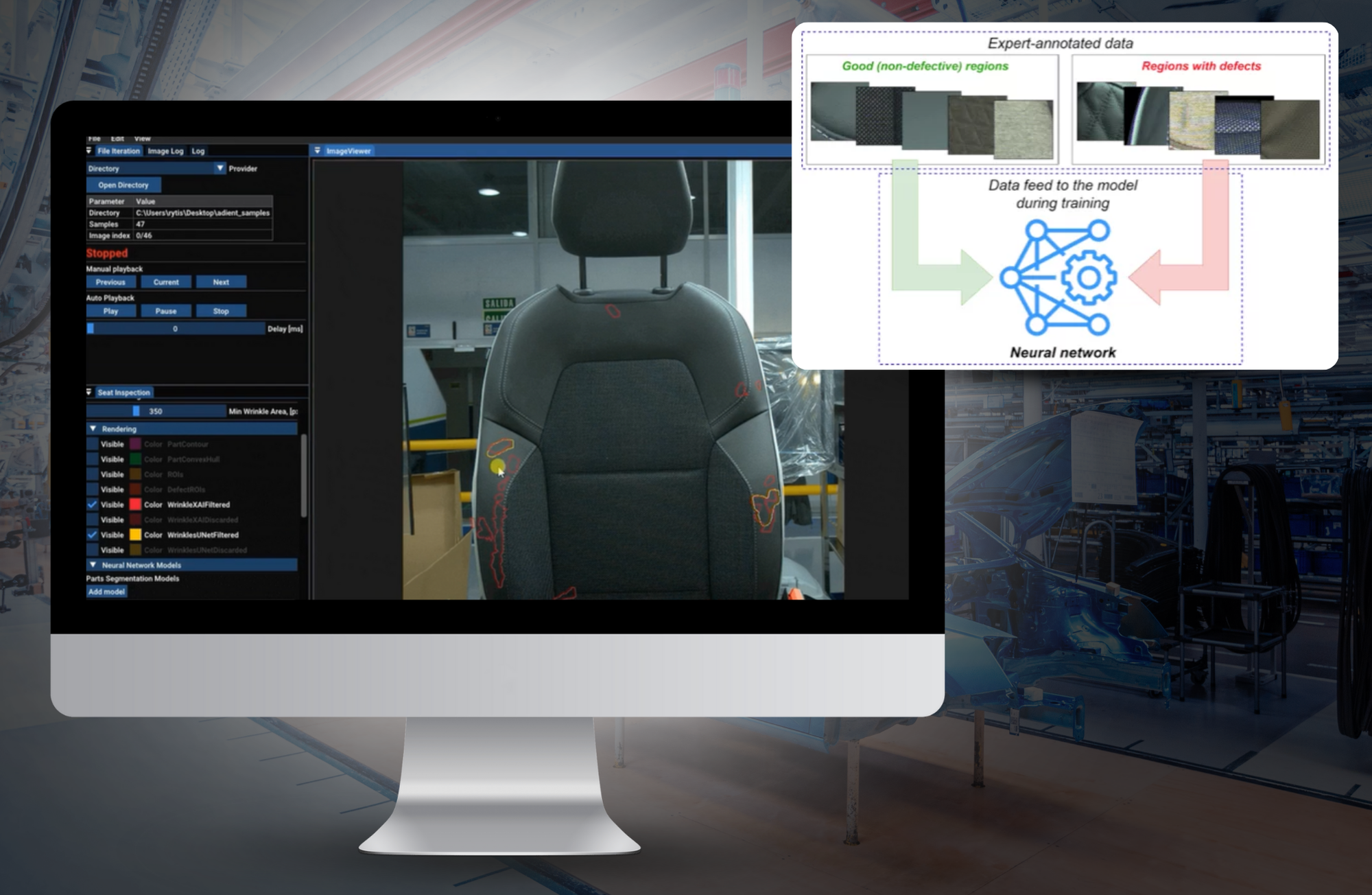Automotive Seats Defect Detection Automation Using Machine Vision AOI
Published on: Apr 24, 2025

Written by: Content team, Intelgic
Automotive Seats Defect Detection Automation Using Machine Vision AOI
In modern automotive manufacturing, maintaining consistent quality standards for interior components is a non-negotiable requirement. Among these, automotive seats—being directly linked to comfort, safety, and aesthetics—demand rigorous inspection processes. Defects, whether minor visual flaws or structural inconsistencies, can lead to increased scrap rates, rework, and customer dissatisfaction. As production volumes scale and product variation increases, traditional inspection methods are proving inadequate. This is where Machine Vision AOI (Automated Optical Inspection) systems offer a scalable and intelligent alternative.
Common Defect Types in Automotive Seats
Automotive seats are composed of intricate assemblies of materials including fabric, leather, foam, and metal. During the manufacturing process, various types of defects can occur, such as:
- Stitching defects (missed, skipped, or uneven stitches)
- Wrinkles or puckering in the upholstery
- Surface blemishes or discoloration
- Cuts, abrasions, or tears
- Improper alignment of panels or seams
- Foreign particles embedded in the seat surface
- Inconsistencies in foam density or fitment
While some defects are easily visible, others are subtle and require close scrutiny—something that manual inspection may not reliably achieve in a fast-paced manufacturing line.

Challenges in Automotive Seat Inspection
- Material and Color Variability
Automotive seats are made from a wide range of materials—leather, fabric, and synthetic blends—in numerous colors and textures. This diversity affects how defects such as stains, wrinkles, or misalignments appear, making uniform and reliable detection more complex.
- Shape and Size Variability
Seats differ in design, size, and configuration (e.g., standard, sport, luxury). These variations introduce unique contours, bolsters, stitching patterns, and headrest shapes, requiring inspection systems to constantly adapt, which complicates accuracy.
- Subtle and Minor Defects
Defects such as micro-wrinkles, faint stains, or slightly misaligned stitching can be very difficult to detect due to their subtle nature and the complexity of the seat's surface.
- Human Error and Inconsistency
Manual inspection is prone to variability. Fatigue, distraction, or differences in judgment between inspectors can result in inconsistent evaluations of seat quality.
- Low Throughput
Manual inspection is slow and labor-intensive. In high-speed production environments, it often becomes a bottleneck, making it difficult to meet demand without increasing workforce size.
- High Labor Costs
Relying on human inspectors adds significant operational cost, particularly when continuous, multi-shift coverage is needed or when inspections must be highly detailed.
Machine Vision AOI: Architecture and Configuration
Machine Vision AOI (Automated Optical Inspection) offers a vital solution by automating the inspection process, ensuring both high accuracy and operational efficiency. The architecture of a machine vision system for automotive seat inspection integrates key components, including area scan cameras, advanced illumination, and real-time live vision software.
Role of Area Scan Cameras
Area scan cameras are integral components in machine vision systems for automotive seat inspection. These cameras capture detailed images of the seat from multiple angles, ensuring thorough inspection across the entire surface.Area scan cameras function by capturing two-dimensional images of a scene in a single exposure. Unlike line scan cameras, which capture images line by line, area scan cameras use an array of pixels to capture the entire image at once, making them ideal for inspecting flat or complex surfaces like automotive seats. The key advantages of areascan camera:
- High Resolution: Area scan cameras offer high-resolution imaging, capturing minute details such as small stitching errors, surface blemishes, color inconsistencies, or fabric imperfections that could otherwise go unnoticed. The clarity and precision of these images are critical for defect detection.
- Multiple Viewpoints:The system utilizes either multiple cameras strategically positioned at the front, rear, left, right, and overhead, or robotic arms that rotate the cameras, ensuring full 360° coverage of the automotive seat. This flexible setup guarantees a comprehensive inspection of all surfaces, including those that are difficult to reach or view.
- Real-Time Image Capture: The cameras operate in real-time, providing immediate visual data for defect analysis. This enables instant feedback during production, allowing for faster decision-making and more efficient quality control.
Advanced Illumination
Lighting plays a crucial role in ensuring that area scan cameras capture the highest quality images, especially when inspecting complex surfaces like automotive seats. Advanced illumination systems are integrated into the inspection process to optimize image quality and defect detection:
- Synchronized LED Lighting: The machine vision system is equipped with synchronized LED lighting positioned strategically around the seat. These lights are synchronized with the cameras to ensure uniform and consistent lighting, reducing shadows and highlighting even the smallest surface defects such as stitching misalignments, wrinkles, or material flaws.
- Adjustable Light Intensity: The illumination system often allows for adjustable light intensity and angle, making it adaptable to varying seat materials and surface textures. This adaptability ensures that the lighting is optimized for different defect types, whether they involve color discrepancies, fabric texture, or surface flaws.
- High-Intensity Lighting: LED lights are used due to their ability to provide high-intensity illumination without producing excess heat. This ensures that the system can inspect high-speed production lines without introducing temperature fluctuations that might affect seat material properties.
AI Software
Intelgic’s Live Vision AI Software acts as the brain of the machine vision system, processing the images captured by the area scan cameras and analyzing them for defects. The software leverages AI algorithms to ensure fast and accurate detection of even the most subtle flaws.
- Instant Image Processing: As images are captured in real time, the software immediately processes the data, performing tasks like defect detection, image segmentation, and pattern recognition. This ensures real-time defect identification without delays, allowing for immediate action if a defective seat is detected.
- AI-Powered Defect Detection: The software uses advanced AI algorithms to analyze the captured images for a wide range of defects, including:
- Stitching errors (misalignments, broken threads)
- Surface imperfections (wrinkles, tears, discolorations)
- Material inconsistencies (color mismatches, fabric defects)
- Contaminants (foreign particles, dust)
- Stitching errors (misalignments, broken threads)
- Automated Classification and Decision Making: Based on predefined criteria and tolerance levels, the software automatically classifies seats as "OK" (acceptable) or "NG" (not good). Defective seats are flagged, and ejection signals are sent to remove them from the production line, ensuring only defect-free seats proceed to the next stage.
- Traceability and Reporting: The system logs defect data for traceability and continuous improvement. Reports can be generated to track trends, monitor defect types, and optimize production processes over time.

Inspection Workflow in Production – Step-by-Step
1. Seat Positioning in Fixed Inspection Station
- Seats are positioned in a dedicated, stationary inspection cell.
- Placement can be done manually by an operator or automatically via a conveyor.
- The stationary setup ensures stability, eliminating motion blur and vibration-related errors.
2. Imaging Hardware for Automotive Seat Inspection
Multiple industrial-grade area scan cameras are strategically placed around the seat or a robotic arm rotates the camera around the automotive seat for 360° coverage to capture all visible surfaces.
3. Optimized Imaging with Synchronized Lighting
Two high-intensity LED lights placed at the front and rear of the seat station ensure uniform and shadow-free illumination. This consistent lighting helps in highlighting defects that may otherwise be missed due to shadows or uneven lighting, ensuring that even the smallest imperfections are detected.
4. Real-Time Image Processing and Defect Detection
- Captured images are processed instantly by AI-driven vision software.
- The system detects and highlights defects such as:
- Stitching misalignments
- Surface wrinkles or tears
- Discoloration
- Foreign particles or embedded materials
- Stitching misalignments
5. Automatic Classification and Decision-Making
- The software classifies inspection results as either "OK" or "NG" (Not Good).
- Decisions are based on predefined defect tolerance thresholds.
6. Result-Based Response and Reporting
- If “OK”, the seat continues down the line.
- If “NG”, the system triggers an automatic ejection, alert, or quality log entry.
- Inspection results can be logged for traceability and compliance purposes.

Key Advantages of Machine Vision AOI for Automotive Seats
- Precision and Repeatability: One of the most significant advantages of Machine Vision AOI is its ability to provide high precision in defect detection. Unlike human inspectors, machine vision systems offer consistent, repeatable results, free from the variability of operator skills or fatigue. This ensures reliable and accurate defect detection every time, even for the most subtle flaws, leading to more consistent product quality.
- Real-Time Inspection: The real-time feedback provided by machine vision systems allows for immediate identification of defects as they are detected. This enables quick corrective action to be taken before a defective seat continues down the production line, minimizing the risk of flawed products reaching the next stages of manufacturing. As a result, production delays are significantly reduced, and overall process efficiency is enhanced.
- Complete Surface Coverage: With the use of multi-angle area scan cameras, the system can thoroughly inspect all surfaces of the automotive seat. This approach eliminates any blind spots that might be missed with manual inspection or single-angle cameras. The 360° coverage ensures that every inch of the seat is examined, capturing defects that could be easily overlooked in a traditional inspection setup.
- Faster Throughput: Machine Vision AOI systems are designed to keep up with high-volume manufacturing environments. The automated, high-speed inspection process allows manufacturers to maintain rapid throughput without sacrificing accuracy. This capability is essential for large-scale production, ensuring that each seat is inspected at a pace that aligns with the rest of the manufacturing process.
- Lower Labor Costs: By automating the inspection process, machine vision systems significantly reduce the dependency on manual labor for quality control. This results in lower labor costs, as fewer human resources are required for inspecting seats. Additionally, it helps to free up personnel for other tasks, improving overall operational efficiency.
- Data Tracking: Machine vision systems continuously log defect data, providing valuable insights into product quality. This data can be used for traceability, ensuring that any defects are documented and can be traced back to specific production batches. The ability to analyze defect data over time also supports continuous improvement efforts, allowing manufacturers to identify recurring issues and make targeted adjustments to enhance quality control processes.
Intelgic’s Expertise in Automotive Manufacturing Quality Control
- Industry Leadership: Intelgic is at the forefront of transforming traditional quality control in automotive manufacturing, offering innovative solutions that elevate production standards.
- Expertise in Machine Vision and AI: With deep expertise in Machine Vision and AI, Intelgic delivers cutting-edge systems that provide real-time, precise defect detection across automotive manufacturing processes.
- Live Vision Software: Intelgic's Live Vision software is recognized for its speed, reliability, and intelligent defect recognition, ensuring high accuracy in identifying even the most subtle flaws in automotive components.
- Tailored Solutions for High-Volume Inspection: Intelgic specializes in creating custom solutions designed to meet the demands of high-volume inspection tasks, ensuring seamless scalability for manufacturers.
- Continuous Innovation: Intelgic’s solutions are constantly evolving, supporting new use cases and adapting to various material types and production processes, enabling manufacturers to stay ahead of industry trends.
- Seamless Integration: Intelgic focuses on easy integration with existing manufacturing systems, ensuring minimal disruption and maximum efficiency in implementation.
- High-Speed Processing and Precision: Intelgic’s systems are built to handle fast-paced production lines without compromising on the accuracy or quality of defect detection.
- Preferred Partner for OEMs and Suppliers: Due to its emphasis on performance, precision, and cutting-edge technology, Intelgic is a trusted partner for automotive OEMs and suppliers looking to enhance manufacturing quality.
Machine Vision AOI has revolutionized automotive seat defect detection, offering precision, speed, and reliability in high-volume manufacturing environments. By utilizing area scan cameras, synchronized LED lighting, and advanced AI-powered real-time software, this system ensures accurate defect identification across every surface of the seat.
Intelgic's expertise in developing and deploying intelligent automation solutions plays a key role in optimizing this inspection process. With specialized knowledge in automotive seat defect detection, Intelgic provides end-to-end machine vision systems that ensure high-quality manufacturing, reduce human error, and improve operational efficiency. Their innovative approach, combining cutting-edge hardware with AI-driven software, helps automotive manufacturers maintain the highest quality standards while streamlining production workflows.

